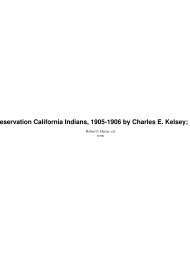The Geography and Dialects of the Miwok Indians - Yosemite Online
The Geography and Dialects of the Miwok Indians - Yosemite Online
The Geography and Dialects of the Miwok Indians - Yosemite Online
You also want an ePaper? Increase the reach of your titles
YUMPU automatically turns print PDFs into web optimized ePapers that Google loves.
1908] Barrett .—<strong>The</strong> <strong>Geography</strong> <strong>and</strong> <strong>Dialects</strong> <strong>of</strong> <strong>the</strong> <strong>Miwok</strong> <strong>Indians</strong> . 357<br />
<strong>The</strong> limited number <strong>of</strong> words in <strong>the</strong>se vocabularies makes it<br />
impractical to attempt to determine <strong>the</strong> exact ma<strong>the</strong>matical relations<br />
existing in respect to <strong>the</strong> number <strong>of</strong> stems held in common<br />
among all <strong>the</strong> dialects or between any two <strong>of</strong> <strong>the</strong>m. Certain<br />
general relations are, however, evident.<br />
From an inspection <strong>of</strong> <strong>the</strong> list it appears that <strong>the</strong> four Sierra<br />
dialects fall into three groups : Plains, Amador-Tuolumne, <strong>and</strong><br />
Mariposa. Of <strong>the</strong>se <strong>the</strong> Plains dialect is <strong>the</strong> most distinct from<br />
<strong>the</strong> o<strong>the</strong>rs, having fully 40 per cent <strong>of</strong> stems entirely peculiar to<br />
itself. <strong>The</strong> Amador <strong>and</strong> Tuolumne dialects are quite closely<br />
united, having about 80 per cent <strong>of</strong> <strong>the</strong>ir roots in common . <strong>The</strong><br />
Mariposa dialect is removed by a considerable degree from <strong>the</strong><br />
Amador-Tuolumne group, having only about 60 per cent <strong>of</strong><br />
stems in common with it. It is, however, much more closely related<br />
to <strong>the</strong> Amador-Tuolumne group than is <strong>the</strong> Plains dialect.<br />
Among <strong>the</strong> three <strong>Miwok</strong> dialects spoken in <strong>the</strong> Coast range<br />
mountains, <strong>the</strong> adjacent Marin <strong>and</strong> Bodega dialects are very<br />
closely related to each o<strong>the</strong>r . <strong>The</strong> connection between <strong>the</strong>se two<br />
is on <strong>the</strong> whole even closer than that between <strong>the</strong> two members<br />
<strong>of</strong> <strong>the</strong> Amador-Tuolumne group.<br />
<strong>The</strong> nor<strong>the</strong>rn Coast or Lake dialect is, however, different from<br />
<strong>the</strong> o<strong>the</strong>r two Coast dialects, <strong>and</strong> probably st<strong>and</strong>s far<strong>the</strong>st removed<br />
<strong>of</strong> any from <strong>the</strong> typical <strong>Miwok</strong> stem.<br />
<strong>The</strong> dialects <strong>of</strong> <strong>the</strong> Coast group are apparently slightly more<br />
related to <strong>the</strong> Plains dialect than to <strong>the</strong> o<strong>the</strong>rs <strong>of</strong> <strong>the</strong> Sierra<br />
region. <strong>The</strong> territory <strong>of</strong> <strong>the</strong> Coast dialects is geographically<br />
nearer to <strong>the</strong> area in which <strong>the</strong> Plains dialect was spoken, which<br />
fact, toge<strong>the</strong>r with <strong>the</strong> somewhat closer lexical relationship,<br />
might be taken to indicate a former actual connection between<br />
<strong>the</strong> people <strong>of</strong> <strong>the</strong> two regions, with a subsequent intrusion <strong>of</strong><br />
Wintun, or with a <strong>Miwok</strong> migration, as <strong>the</strong> cause <strong>of</strong> separation.<br />
However, <strong>the</strong> coast dialects contain so many totally different root<br />
forms from those found in <strong>the</strong> dialects <strong>of</strong> <strong>the</strong> Sierra group, that<br />
whatever <strong>the</strong> cause <strong>of</strong> separation may have been, it seems probable<br />
that <strong>the</strong> separation itself has been <strong>of</strong> long st<strong>and</strong>ing.<br />
In both <strong>the</strong> Coast <strong>and</strong> <strong>the</strong> Sierra groups <strong>the</strong>re are a few<br />
terms borrowed from surrounding languages, but <strong>the</strong>ir number




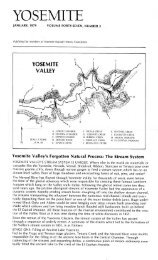
![(March 1982) [PDF] “We Are Pleased to Announce†- Yosemite Online](https://img.yumpu.com/51299748/1/190x242/march-1982-pdf-aeuroewe-are-pleased-to-announceaeur-yosemite-online.jpg?quality=85)
![[PDF] Old Horny, Yosemite's Unicorn Buck - Yosemite Online](https://img.yumpu.com/51269869/1/184x260/pdf-old-horny-yosemites-unicorn-buck-yosemite-online.jpg?quality=85)
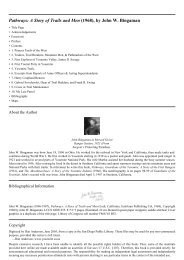
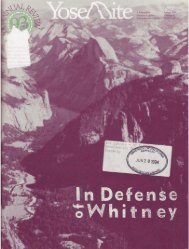
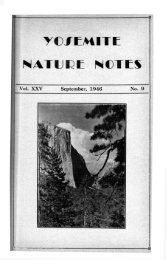
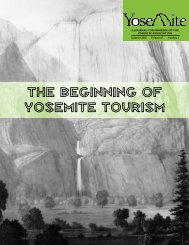
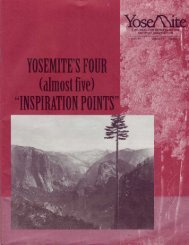
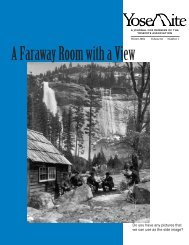
![1985 [PDF] - Yosemite](https://img.yumpu.com/48128837/1/184x260/1985-pdf-yosemite.jpg?quality=85)

